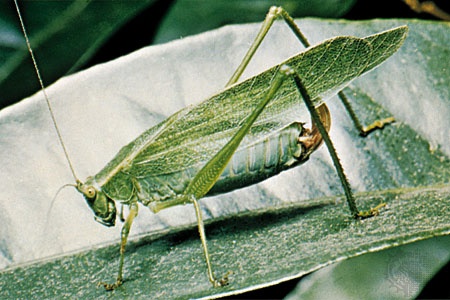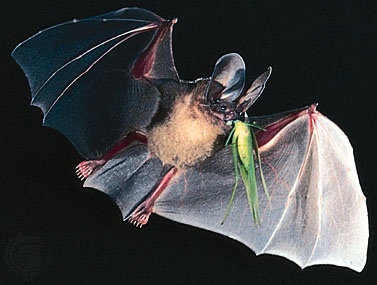katydid
insect
 any of numerous, predominantly nocturnal insects related to crickets and grasshoppers, noted for their loud mating calls. Katydids have large hind legs and are distinguished by their extremely long, threadlike antennae and the thick, upwardly curved ovipositor (egg-laying structure) of the females. Often large and green, many katydids have long wings, but some common species are nearly wingless. Katydids are most abundant in the tropics—the Amazon rainforest is home to about 2,000 species—but katydids are also found in cooler and drier regions throughout the world; the United States is home to over 100 species. They live on trees, bushes, or grasses, often matching the appearance of their surroundings. Many species resemble leaves; leaf-katydids of the American tropics precisely mimic partially eaten or otherwise disfigured leaves. Owing to such adaptations and their lack of daytime activity, relatively little is known of this group of insects, despite their ubiquity, abundance, and variety.
any of numerous, predominantly nocturnal insects related to crickets and grasshoppers, noted for their loud mating calls. Katydids have large hind legs and are distinguished by their extremely long, threadlike antennae and the thick, upwardly curved ovipositor (egg-laying structure) of the females. Often large and green, many katydids have long wings, but some common species are nearly wingless. Katydids are most abundant in the tropics—the Amazon rainforest is home to about 2,000 species—but katydids are also found in cooler and drier regions throughout the world; the United States is home to over 100 species. They live on trees, bushes, or grasses, often matching the appearance of their surroundings. Many species resemble leaves; leaf-katydids of the American tropics precisely mimic partially eaten or otherwise disfigured leaves. Owing to such adaptations and their lack of daytime activity, relatively little is known of this group of insects, despite their ubiquity, abundance, and variety.The katydid derives its name from the male's repetitive call, which has been phoneticized as “katydid, katy-didn't.” One European term for katydid, “tizi,” also sounds similar to the insect's call. Each species has its own rasping song, produced by stridulation; among katydids this consists of rubbing the forewings together, one of which is ridged. Both sexes hear using a structure called a tympanum, or tympanic organ, one of which is located on each foreleg.
Wing form and function varies widely among katydids. As a group these insects are poor flyers, despite wingspans of 20 cm (8 inches) among some tropical residents. Many species do not fly but only flutter their wings during leaps; the others expose brightly coloured hindwings as a form of defense. Eggs are laid within or upon various living or dead plant material, depending on the species. The young are similar to adults but have less-developed wings. Katydids feed chiefly on plant matter, though several also eat other insects.
Katydids may be central to the food webs of tropical forest ecosystems, where they serve as a primary source of animal protein for monkeys, rodents, bats, birds, lizards, amphibians, and spiders, along with other insects. Panama alone is home to over 150 species.
 Katydids, crickets, and grasshoppers are all orthopterans (orthopteran). The term katydid may be used to refer to some members of the long-horned grasshopper family, Tettigoniidae. Although tettigoniids are called grasshoppers (e.g., the meadow grasshopper and the cone-headed grasshopper), “true” grasshoppers belong to a different orthopteran suborder (Caelifera). Katydids are more closely related to crickets than grasshoppers, as katydids and crickets belong to the same suborder (Ensifera). The Tettigoniidae family consists of about 6,000 species divided into 1,070 genera and 19 subfamilies.
Katydids, crickets, and grasshoppers are all orthopterans (orthopteran). The term katydid may be used to refer to some members of the long-horned grasshopper family, Tettigoniidae. Although tettigoniids are called grasshoppers (e.g., the meadow grasshopper and the cone-headed grasshopper), “true” grasshoppers belong to a different orthopteran suborder (Caelifera). Katydids are more closely related to crickets than grasshoppers, as katydids and crickets belong to the same suborder (Ensifera). The Tettigoniidae family consists of about 6,000 species divided into 1,070 genera and 19 subfamilies.The true katydids make up the subfamily Pseudophyllinae. Those in the genus Pterophylla, are the true katydids of eastern North America. The sylvan katydids of Panama are also pseudophyllinids (see video). The 50-plus species are generally large and mimic a variety of botanical forms, including bark and leaves—both living and dead. Males and females can produce sound when distressed.
The subfamily Phaneropterinae is another large subfamily of tettigoniids. Its members are sometimes called the false katydids, or bush katydids. Their songs are a series of high-pitched ticks or lisps. In Panama, it is thought that such short, high-frequency calls make the insects' detection more difficult for bats. These tropical species can measure over 120 mm (4.7 inches) long and range in colour from green to brown, although some are white, pink, or yellow. They are also notable in that both sexes produce mating calls.
The subfamily Phaneropterinae also includes the round-headed katydids and the angular-winged katydids. The fork-tailed bush katydid (Scudderia furcata) has long, narrow tegmina (hardened leathery forewings) and often licks its feet to clean the adhesive pads found there. The round-headed katydid (Amblycorypha) has oval wings that are wider than those of the bush katydid. The angular-winged katydid (Microcentrum) has a flattened, humped back; its wings resemble large leaves. In flight, Microcentrum holds its wings in a gliderlike position.
The African katydids of the subfamily Saginae are predators, as are the Australian flightless katydids of the subfamily Austrosaginae. Members of Listroscelidinae and Conocephalinae species of the latter subfamily bite severely enough to cause bleeding.
- Chalcedon, Council of
- chalcedony
- Chalchiuhtlicue
- chalcid
- Chalcidian alphabet
- Chalcidian League
- Chalcidice
- Chalcis
- chalcocite
- Chalcocondyles, Laonicus
- Chalcolithic Age
- chalcopyrite
- Chaldea
- Chaldean Catholic Church
- Chaldean rite
- chalet
- Chaleur Bay
- Chalfie, Martin
- Chalfont St. Giles
- Chalgrin, Jean-François-Thérèse
- Chaliapin, Feodor
- chalice
- Chalicotherium
- chalk
- chalk drawing